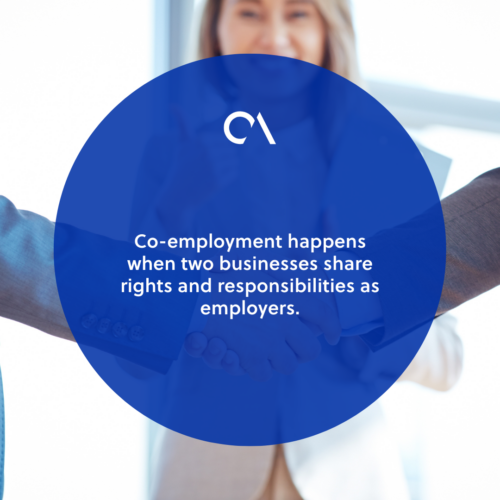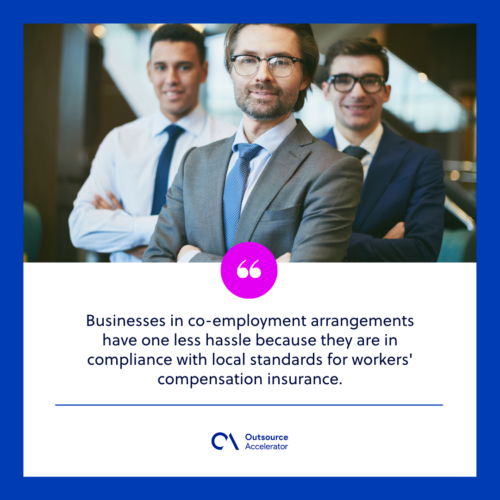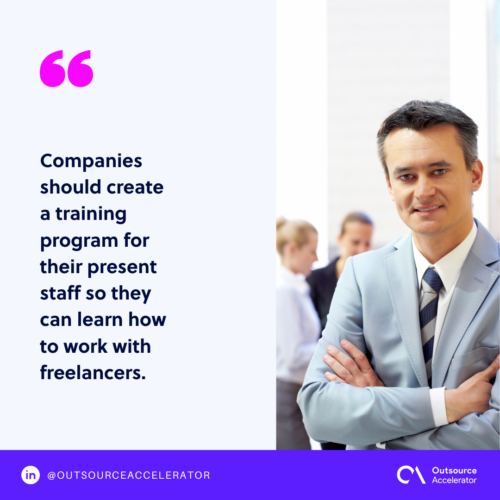Co-employment: Definition, benefits, and risks

For years, misinformation and misunderstanding have surrounded co-employment. Because of this, many companies have chosen to ignore it.
However, it has become increasingly challenging to do so as more companies rely on independent professionals like freelancers to complete jobs.
Co-employment hazards typically arise when companies are unsure of their rights and obligations when collaborating with these outside experts. Once the company knows the basics, it can confidently use independent specialists’ vast range of expertise and abilities.
What is co-employment
Co-employment occurs when two businesses share rights and responsibilities as employers. Staffing companies typically hire independent contractors for their clients.
While the corporation handles the work agreement and job responsibilities, the staffing firm generally handles HR tasks like hiring, payroll, and recruiting.
In this approach, the worker is theoretically employed both by the firm and the co-employer. Both the staffing agency and the customer can be regarded as employers because they have duties to the contractor.

Benefits of co-employment
Co-employment is frequently discussed as benefiting firms, but it also has advantages for employees.
The following are some advantages of co-employment:
Access to big-business benefits
The co-employment partner can pool all of its customers for increased purchasing power. This allows the smaller company to provide big-business benefits through co-employment partners.
Employees may benefit from a greater variety of options, often at a lesser cost.
Simplified payroll
The co-employment partner is also in charge of paying worksite employees and paying, filing, and reporting payroll taxes under its tax number.
This streamlines the company’s payroll process, allowing it to concentrate on other business aspects while ensuring accuracy and compliance.
Workers’ compensation
Businesses in co-employment arrangements face fewer hassles because they are in compliance with local standards for workers’ compensation insurance.
Co-employers offer insurance to their clients and manage any potential claims.
In order to reduce workplace accidents and employer responsibility, they can also conduct safety audits and suggest training programs for employees.
Strategic HR support and planning
A co-employer can also serve the HR needs of companies that lack or don’t want to employ dedicated internal HR resources.
Strategic HR support and planning play a crucial role in navigating complex co-employment relationship.
Through strategic planning, HR teams can address potential challenges, promote communication, and align goals to sustain a successful co-employment arrangement.
Depending on the amount of support needed, clients in co-employment arrangements could have a specialized HR specialist or team that offers strategic and administrative services.
On the other hand, if a business already has its own resources, it can keep using them and collaborate with the co-employer if more knowledge or support is required.

Co-employment risks and how to avoid them
Although co-employment can help businesses with some of the administrative hassles associated with hiring independent contractors, it does not eliminate all associated risks.
Joint employment co-employment arrangements can lead to shared liability and legal obligations between multiple parties, making it essential to clearly define roles and responsibilities in the contractual agreement.
Here are some of the known risks of co-employment and how to avoid them:
Worker classification
The risk: More often than not, independent contractors are not properly classified by businesses. Any company entity may experience several future annoyances as a result.
No business would want to be accused of employee misclassification during an audit. Therefore, it is important that each independent contractor undergoes a thorough screening.
How to avoid it: Businesses must keep up with the most recent co-employment rules and regulations. They also need to make sure to go over the classification standards with any external staffing agencies they plan to work with in advance.
Treatment of independent contractors
The risk: One of the main issues with co-employment is handling independent contractors as internal employees. It’s possible that the independent contractor, the business, and its team get along well at work.
The company needs to establish certain limitations. Extreme reliance on independent contractors may cause problems with workflow.
How to avoid it: Companies should create a training program for their present staff so they can learn how to work with freelancers. The in-house staff should also be informed about the appropriate amount of internal information to provide to independent contractors.
Ultimately, independent contractors and freelancers should be treated as separate corporate entities.
Getting the right partner or contractor
The risk: It might be difficult to identify a co-employer or a freelancer who is excellent to work with. Companies that are seriously thinking about getting co-employment should never ignore this.
When entering a co-employment agreement, businesses should remember that they are disclosing sensitive information to a third party. Not paying close attention to the identification component can lead to questionable results.
How to avoid it: Assess the reasons for co-employment. This makes it clear what type of partnership would be best for them. Once they have a solid requirement, they can start looking into the top co-employer service in the market and make a list of their choices.
Top selections should be scheduled for a demo or introduction call. Companies get the opportunity to ask any questions about the services and job situation.
Once the vendor has been chosen, it is time to propose a contract.
When drafting a contract, companies must remember that the indemnification language, which specifies who is accountable for claims when something goes wrong, is the most important part.

Co-employment is great if done right
Co-employment has numerous advantages when done right, both for workers and businesses.
Organizations should consider it, especially when they properly designate their workers and employees. They must also ensure that all employment laws are observed.
A harmonious relationship can be maintained by ensuring a clear delineation of employer responsibilities between the professional employer organization and the client company.
With PEO managing employment taxes and regulations, clients can focus on core business for increased productivity.
However, accurate categorization is extremely important. This is especially true when dealing with independent talent. This can be avoided by being familiar with the basics of working with independent contractors and seeking assistance when necessary from the appropriate partners.







 Independent
Independent




